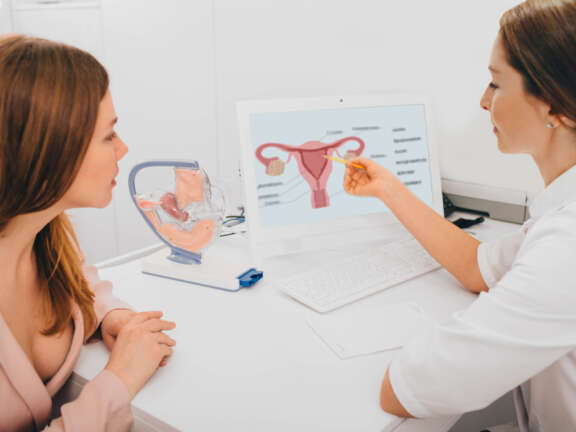Uterine Fibroid Embolization: Is It Right for You?


Fibroids are benign (non-cancerous) tumors that develop in the uterus. They are very common, occurring in up to 80% of women, usually between 30-50 years old.
For most women, fibroids are asymptomatic. However, they grow slowly over time and the larger they become, the more likely they will start to cause symptoms. Approximately 25% of women with fibroids develop symptoms, including:
- Heavy, painful, and/or prolonged menstrual periods
- Bleeding between periods
- Chronic pelvic pain
- Pain during sex
- Frequent urination
- Urinary urgency
- Constipation
- Abdominal fullness or swelling
- Lower back pain
- Anemia
Fibroids can also contribute to infertility and increase the risk of miscarriage.
If your fibroids aren’t causing you any problems, there is no need to treat them. But if you do have symptoms like those listed above, treatment can provide much-needed relief. Typically, this includes medication (a short-term solution for symptom relief) and/or surgery.
There are several factors to consider before deciding if surgery is right for you, including size, location, and number of fibroids, as well as your desire for future pregnancies.
Myomectomy
This is a procedure that removes just the fibroids, preserving your uterus. This is a good option if you want to carry children in the future. However, research shows that fibroids grow back in roughly 20% of women who have myomectomies.
Hysterectomy
A hysterectomy is the surgical removal of the uterus. Without a uterus, you never have to deal with fibroids again. However, this is a major surgery with potential complications and several weeks of recovery time. Plus, hysterectomies make future pregnancies impossible.
Uterine Fibroid Embolization
Uterine fibroid embolization (UFE) is performed by an interventional radiologist—a medical doctor specializing in minimally invasive procedures that are guided by imaging (MRI, CT scan, ultrasound, etc.).
During this procedure, the radiologist inserts a small catheter into the radial artery in your left wrist. Small particles are then injected into the vessels that deliver blood to your fibroids, blocking the flow of blood. Over time, the fibroids shrink and eventually die. Because everything is done through a tiny puncture in the wrist, there are no major incisions and no stitches.
The providers at Innovista Medical Center can help diagnose fibroids. But if treatment is needed, we refer patients to gynecologists or specialists such as those at the Fibroid Institute of Texas, a team of interventional radiologists who specialize in UFE.
You may be a good candidate for UFE if you:
- Have fibroid symptoms that are interfering with your life.
- Are not a good candidate for myomectomy or hysterectomy.
- Want to avoid surgery.
- Wish to keep your uterus.
- Want a shorter and less intense recovery time.
- Do not have any other pre-existing conditions like gynecological cancer, pelvic infections, significant peripheral vascular disease, or uncorrectable bleeding problems.
- No longer wish to get pregnant. (While it is still possible to become pregnant after UFE, research shows there is a higher-than-average risk of miscarriage and other complications.)
What can you expect during a consultation?
Consultations can be done in person or virtually. Your initial consultation is meant to share information and discuss different treatment options. There is usually no physical exam necessary, especially if you already have documentation by a gynecologist or other health care provider that you have fibroids.
During this appointment, you be given an order to get a pelvic MRI. Once the images are received, you will be scheduled for another appointment to discuss what the doctor sees and what your best treatment options are.
How long does UFE take?
The procedure takes about one hour. The total time in the clinic is three to four hours. Patients arrive one hour prior to their procedure time and stay one to two hours afterward to be monitored before they go home.
What does recovery look like?
After UFE, most patients don’t have any pain or limitations but are advised to take it easy for about one week. It’s not unusual to be able to return to work within a few days, provided your job isn’t physically challenging or rigorous.
Any post-UFE discomfort (called post-uterine embolization syndrome) is a result of inflammation and the body’s natural response to cutting off blood supply to the fibroids. Symptoms usually subside after one week and can include:
- Mild cramping
- Light spotting or discharge
- Nausea/vomiting
- Low-grade fever
- Hot flashes or night sweats
- Decreased appetite
- Fatigue
You will have one-week, one-month, and four-month follow-up appointments to assess your healing progress.
What is the success rate of UFE?
UFE has a nearly 90% success rate in reducing or eliminating symptoms. For the remaining 10%, another UFE may be needed to fully eliminate symptoms.
Most women notice shorter, lighter periods by the first menstrual cycle after UFE. The rest of the fibroid-related symptoms (called “bulk symptoms”) usually subside after a couple months.
Is UFE covered by insurance?
UFE is covered by most major insurance carriers, including Blue Cross and Blue Shield of Texas plans. If you have a Blue Cross and Blue Shield of Texas HMO plan, you will need a referral from your Innovista Medical Center provider.
Does Fibroid Institute of Texas have Spanish translation capabilities?
Yes, and literature/brochures are also available in Spanish.
Where are offices located?
Fibroid Institute of Texas has locations throughout Houston and Dallas. There are four clinics in Houston (Sugar Land, Katy, Clear Lake, and The Woodlands) and eight in Dallas (Addison, Arlington, Dallas, Duncanville, Euless, McKinney, Mesquite, and Sherman).
To read more about fibroids and uterine fibroid embolization, hear success stories from real patients, and learn about the doctors at the Fibroid Institute of Texas, visit www.fibroidfree.com.
To talk to someone or schedule a consultation, call 214-838-6440 if you live in Dallas or 713-903-3733 if you live in Houston.
